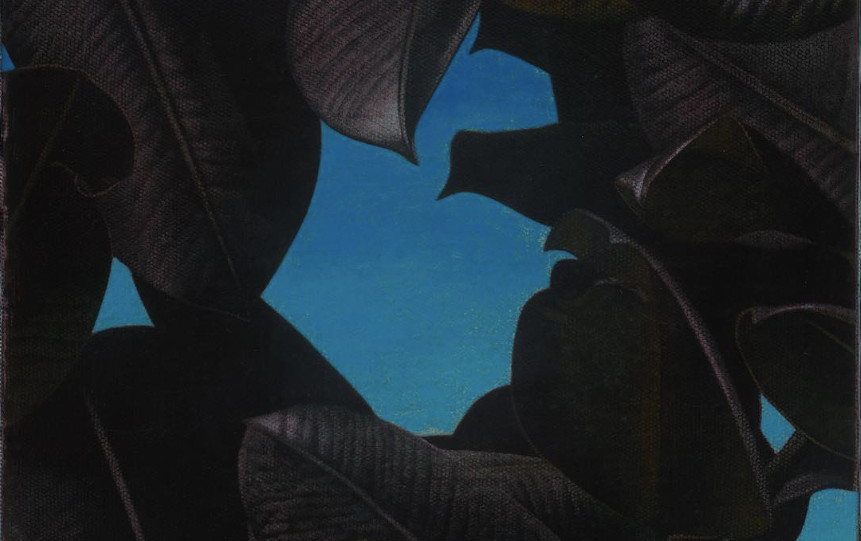
6 October - 5 November
The Lamentation over the Dead Christ is a painting made by Andrea Mantegna in 1480. At first glance it reads as a fairly literal rendition of a much-imagined scene – Christ peacefully lays on a marble slab, under a thin cloth as a tearful Virgin Mary, Saint John and St Mary Magdalene loom over. On closer viewing, and the reason why the painting sparks a befuddled hold over Oliver Osborne and art historians alike, is due to the stark foreshortening of Christ’s body: his midriff appears compressed while his head and feet seem proportionally erroneous. For Oliver’s exhibition, titled ‘Mantegna’s Dead Christ’, the recumbent Christ appears again, only this time as a spirit. Mantegna’s Dead Christ [Figure 1] emerged after Oliver exposed an acetate rendition of Mantegna’s masterpiece on the roof of his house in summer – the faint lines of Christ sun-scorched onto a strip of packaging paper. It’s one of two pieces in the exhibition described by Oliver as ‘anchors’ – important markers which reverberate through the history of painting. Untitled [Figure 2] is an abstract painting of a grid, reminiscent of a window, hovering in and out of focus depending on where you stand; recalling the paintings of the late Ad Reinhardt, squares dissipate behind swathes of monochrome. Oliver’s paintings in a similar effect to his Mantegna’s Dead Christ, feigns the impressions of sunlight, akin to how our eyes sparkle to adjust when walking into light from a darkened room. He achieves this effect by fastidiously sanding down layers of white acrylic on gessoed linen – scrubbing away to reveal looming ghosts behind. Oliver is likely best known for his studies of rubber plants, having painted them now for a decade. At Union Pacific, they lurk in varying abundance across numerous canvases. Of the three that solely depict them, each named Untitled [Figure 3], they emerge from gradient skies in shades of blue, beige and turquoise reminiscent of hues from early 19th-century French painting. His intuition for the plant’s anatomy, having made myriad renditions of varying vibrance, means he refers back to his own past paintings for guidance rather than to the plant itself. Through the process of repetition, Oliver’s subjects become removed from their initial context – made more his own through subtle tweaks of composition and chiaroscuro. Every painting he makes under these terms becomes referential to itself and to himself; a practice of looking inwardly. The series of paintings, all titled Barbara Villiers [Figure 4], declare a similar distancing from the source, each loosely depicting Villiers, the mistress of King Charles II, whose strikingly sullen, cocked pose became the subject of numerous portraits during the 17th century. By choosing to paint her again, here submerged in increasingly more washed out green hues, Oliver reels us further into ‘a dusty corner of painting history’ – this time revealing a biographical coincidence: his wife is also called Barbara. Jumping centuries ahead to the 1990s, Oliver’s compass of painting history presents us with a singular portrait of Luxembourgish artist Michel Majerus, Michel Majerus (from the Albrecht Fuchs photograph) [Figure 5], originally captured by Fuchs in 1997. Before his sudden death in 2002, Majerus pioneered a painting style refracting the evolving digital world around him. Oliver wrote, in a 2017 review for Mousse Magazine that, Majerus ‘didn’t live to see the full force of the internet unleashed, but he casts a long shadow for those artists who have.’ A further sweep of the 17th century awaits in two portraits of Elisabeth of the Palatinate, princess and daughter of the brief ‘Winter Queen’, Elizabeth Stuart. Oliver has painted her repeatedly and in varying luminosity before, in both Untitled [Figure 6] paintings, where they descend into the omnipresent green hue of the exhibition. He used his previous compositions as visual reference, and those ubiquitous plants also creep in again, alongside flashes of pentimento – ghosts of an Elisabeth holding a more arresting gaze. All presented behind glass, these subtle sleights of hand appear across almost every painting, in commemoration of Mantegna’s perspective tricks. In Untitled (Selbstbildnis) [Figure 7], we witness a final throwing down of the curtain: a self-portrait of Oliver hovers between a painted frame and a wooden one. This cameo unravels much of the exhibition’s key motifs – a cocked pose, foreshortening and inward looking – but this time, reflected through the mirror of his iPhone. And, with it, looms the enduring enigma of Mantegna, who’s spirit looks over, never entirely out of sight.